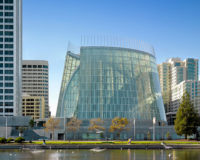Background Notes: The Parthenon and its Panathenaic Frieze
The marble for this stunning octastyle, peripteral, Doric temple (with Ionic architectural elements), came from nearby Mount Pentelikon. It was designed to house a huge statue of Athena Parthenos ( 26 cubits tall, or just over 36 feet in height) which Phidias sculpted in ivory and gold. Indeed, the statue of Athena wore enough removable gold plate to operate as something of a bank. As Neils points out in The Parthenon Frieze, “Given all this gold (44 talents) this statue was the symbolic if not physical embodiment of the Delian Treasury.”
To pay sufficient homage to Athena, a Panathenaic festival took place every four years, with smaller ones occurring annually. This festival of games also commemorated the war between the gods and giants and culminated with a procession through the city of Athens, ending up on the Acropolis. The precise days the festival took place are not certain, but according to Neils in Goddess and Polis: The Panathenaic Festival in Athens, (1992), it lasted from the 23 to 30 Hekatombaion, (the first month of the Athenian calendar) which would place it in late July or the beginning of August. The Panathenaic Procession occurred on the 28 Hekatombaion, traditionally believed to be Athena’s birthday. Not only did the procession include the athletes participating in games, but, among others, it involved women—usually aristocratic ones. Female participants had woven a peplos, a saffron-colored tunic, 5 feet by 6 feet in size, which was mounted on a float, like a sail on a ship, and carted through Athens. In addition to the peplos, the Panathenaic Procession included animals (such as a hecatomb or 100 heifers) for sacrifice.
Beginning at the Dipylon, the major gateway to Athens, the Panathenaic Procession wended through the potter’s quarter (Kerameikos) along the processional way through the Agora—the city’s judicial, commercial and recreational center. Once the parade got up to the Acropolis, the peplos was taken off the cart and the group made its way through the Propylaea and past the Parthenon to a point where animal sacrifices were conducted at the altar of Athena Polias. Then the peplos was presented to Athena’s cult statue in the Erechtheum (421-407 B.C). Famous for its north porch of Caryatids, the Erechtheum replaced an older temple where rituals were held, and is generally thought to have been designed by Mnesicles, the architect for the Propylaea.
The Parthenon’s famed Panathenaic Frieze, thought to represent the festival, depicted horsemen and chariots, gods and goddesses, plus heroes of the Battle of Marathon and, unusual for such art works, normal Athenians participating in the procession. The frieze ran the length of the Parthenon along the corridor (pteroma) between the peristyle and the cella (or naos) starting at the southwest corner, and continuing around the building to terminate on the inner core of the east side, above the columns of the inner vestibule (pronaos). Since the Panathenaic frieze was placed approximately 40 feet above ground level, and the panels were about 3-feet 4-inches high and about 2 feet wide, the frieze would have been too high on the inner walls (or above the inner columns on the short ends) to be seen well from close up. As Richard Stillwell (Hesperia 38, 1969) has pointed out, visitors viewed it on the outer platform below the colonnade, gazing at the frieze obliquely between the columns, as they moved around the building. This vantage point, plus the shadowy reaches, explains why the top of the frieze was carved in higher relief than the bottom.
Although the Panathenaic frieze is attributed to Phidias, it is thought that he oversaw a group of sculptors, although disagreement about actual dates of execution differ: For example, Ian Jenkins in The Parthenon Frieze (1994) maintains the frieze was carved in situ between 438-432 B.C. at the time of the Parthenon’s pediments. John Oakley in a review of the book (Classical World, April 1997) argues that the frieze’s style indicates it was probably carved earlier, from 442-438 B.C., which would mean that some blocks were carved before their installation.
More information continues to be revealed as the current restoration of the Parthenon continues. To recognize the importance of the new museum along with the significance of past archeological endeavors, Columbia University’s Miriam and Ira D. Wallach Art Gallery in New York has installed an exhibition The New Acropolis Museum, which is open to the public from October 21 through December 19. The show displays not only photographs, drawings and models of Tschumi’s museum, but casts of sculptures, books and other archeological material relating to the Acropolis. In this way, it brings together the work of Tschumi, who was dean of the Graduate School of Planning and Preservation from 1988 to 2003 and the contribution of archeological and art historical studies of William Dinsmoor, a professor at Columbia from 1919 to 1963.



